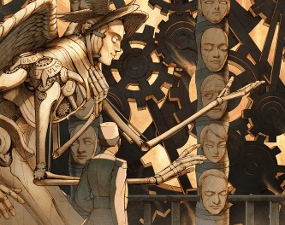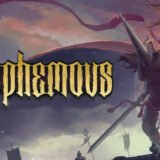
I try not to “follow the crowd,” as it were, preferring to find good genre books and movies on my own or through friends’ recommendations. Today I’m going to talk about a couple of TV series (actually, Netflix series) that I pased over when they debuted. The Witcher showed up in December of last year, and Dracula premiered on the first day of this year, and I was not overly impressed by the short descriptions I read of the two. However, thanks to reading a number of laudatory comments by people whose opinions I respect, I decided to give both a chance.
And I am very glad I did, so will give you my opinion of both these Netflix offerings. This week I will talk about The Witcher; next column Dracula.
***Be aware I will be giving spoilers for both series!***
Because I’ve never even seen the book series or games that this originated as (which have been out there for some time), the first description I read of The Witcher read something like “Henry Cavill (Superman) stars as Geralt of Rivia, a mutant monster-hunter in a world where people are often worse than monsters.” And it came with a picture of Cavill in a blond wig and studded leather armour. No, thanks, not my cup o’ tea. But after half a dozen almost fawning comments on Facebook—and even though I’m not a big fan of what I call “generic pseudo-medieval fantasy”—I decided to give it a try. So the Beautiful and Talented Lynne Taylor Fahnestalk and I sat down to watch the first episode.
Right away I was impressed with the “medieval” settings, though not terribly so by the script; a bunch of invented names and places, and a dribble of information about Witchers. The first monster we see (called a Kikimora), is a water-dwelling thing of tentacles and poky bits with a humanoid head and torso, and Geralt fights and finally defeats it in a pond. Okay, that was kind of cool. Anyway, we watched the first couple of episodes and I, at least, found them good. The B&T Lynne wasn’t impressed as much, I think.
So I watched the rest, and enjoyed them. Here’s my impression:
The first season of this show features Henry Cavill (you’d never know he was British by his accent, either in this or the several Superman movies he’s in) as well as a bewildering array of good, bad, and mediocre characters. He’s Geralt of Rivia, a “Witcher.” A witcher is a monster-hunter for hire, it seems. Geralt is known as “The White Wolf” (from his sigil) as well as “The Butcher of Blaviken,” from a town (Blaviken) where he was attacked by a witch and a group of her followers and killed them all. He was then run out of town by the townspeople.
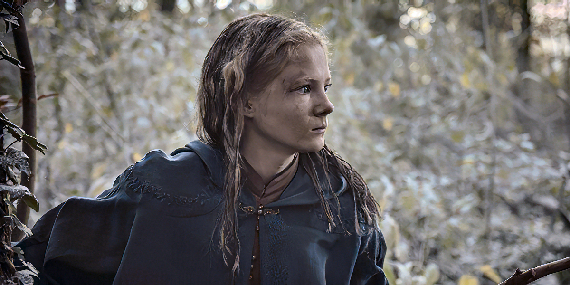
The most significant of the other characters are, beginning with Ciriilla (called “Ciri”) of Cintra, the Lion Cub of Cintra, daughter of the Queen of Cintra. She is bound by “destiny” (if you’re like me, and a fan of Young Frankenstein, count the number of times you find yourself chanting “Destiny! Destiny! No escaping Destiny!”) to Geralt because of something called The Law of Surprise. More on that later. Ciri is played by Freya Allan. In some ways she reminds me of the young Saoirse Ronan in Hanna, and although she’s pretty much the victim in Season 1, though there are a couple of places where she shows she’s not powerless. I believe she may become more of a force in Season 2.

The next major character is named Yennefer, and played by Anya Cholatra. She starts out as the deformed step-daughter of a pig farmer, but becomes a powerful (and beautiful) mage partway through the season. One thing I liked about this series is that magic (which they call “control of chaos”) has a cost here. If they use magic, someone usually has to pay a high price for it. Yennefer pays some very high prices; she becomes one of the most significant characters in the season.
Lesser, but still major characters are Ciri’s mother, Calanthe (Jodhi May), the Queen and Lioness of Cintra; who knows that Ciri (pronounced like “Siri,” by the way) is bound by destiny to Geralt, but who refuses his offer to take her out of Cintra to protect her. She believes that she—as a famous warrior—and her army and navy will be enough to protect Cintra from the armies of Nilfgaard, led by Cahir (Eamon Farren), which have swept through the southern continent and are about to attack Cintra on the Emperor of Nilfgaard’s orders, to retrieve Ciri, though we don’t know why.
(Interestingly enough, “Nilfgaard” is reminiscent of the Norse word “Niflheim,” which is the equivalent of our Hell, and which translates to “Fog World”…some of the names of places, things or people are rough equivalents to English words, like fauns, or dryads (both words stolen from the Greeks, if I remember correctly.)
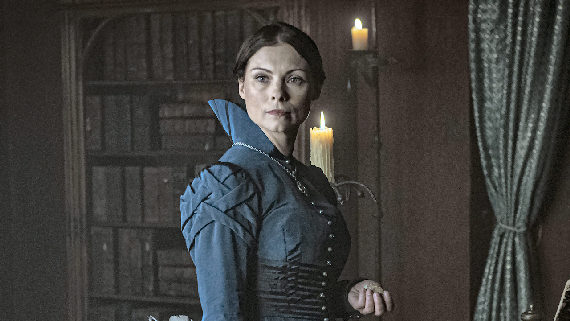
Also, Yennefer and the other female mages are recruited and taught by Tissaia, played by MyAnna Buring. Tissaia has no problem allowing young would-be mages to injure themselves (Fringilla, for example, a young black woman, played by Mimi Ndiweni, who learns first-hand of the dangers of magic) by the wrong application of magic; or letting them be permanently disfigured or worse for the same reason. Fringilla ends up as mage to Nilfgaard’s army, by the way. Tissaia knows that not all young women who are called can become mages; some end up as conduits between mages and chaos. One of Tissaia’s favourite sayings is “Sometimes the best thing a flower can do is to die.”
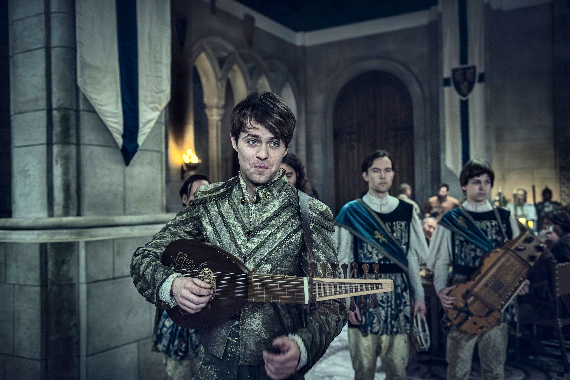
We will also come to know (and possibly be annoyed by—after all, Geralt is definitely annoyed by him—the bard/minstrel Jaskier, or Dandelion, played to the hilt by Joey Batey. Dandelion’s ambition is to become famous by writing, singing, and promulgating ballads about Geralt throughout the civilized lands. And, of course, to get in trouble with as many ladies, noble or otherwise, married or not, as he possibly can. (He appears to be actually playing that lute, something that seldom happens in TV or movies.)
Background: according to something told to Geralt by one of the elves, the world was mostly owned by the elves, until something called The Confluence of Spheres (I think) happened, and humans came into the world… the elves taught the human mages how to harness chaos, and the humans promptly displaced the elves. There was an event called The Cleansing in which humans killed thousands of elves—men, women, and children. (We are an untrustworthy bunch, aren’t we?) A state of extreme dislike exists between the remaining elves and humans.
There are several character arcs happening, but none so extreme as that of Yennefer. When you first see her, she’s a deformed “pig-girl” (Tissaia, during the early stages of Yennefer’s mage apprenticeship, calls her “piglet” and other similar epithets); in the middle of the season she is a mage in full control of herself, beautiful and arrogant; and by the end of the season she’s done a reversal and become, one thinks, a better person.
In the early part of her mage training, she gets a friend/boyfriend/lover
One thing that might confuse viewers is that the timeline in this series is hardly straightforward. It jumps around in time; you might see Ciri with her mother a couple of episodes after you’ve seen Cintra sacked and burned. Another thing this series has is lots of nudity, so if that bothers you, you might want to stay away. Unlike Game of Thrones, there’s no full-frontal, although a lot of “full-backal” (ha!); said nudity is something my wife says is “now de rigeur for non-network TV, thanks to GoT.” (The first time we see it, my wife said something like, “Look! Naked women! What a surprise!” </sarcasm> My Featured Image shows Geralt sitting at his ease in the hot tub; maybe a treat for women (or men) who didn’t realize that he really is built like Superman!
An interesting facet is that both humans and elves appear to come in both light- and dark-skinned varieties. Ciri’s young helper when she gets lost is a black male elf; Fringilla, the mage, is a black woman, and her uncle is one of the bigwigs of the Council of Mages. (Mages come in both male and female versions, though most of the ordinary people just call the females “witches.”) If there are Asians in this world, I think I missed them.
I think Henry Cavill’s terse speech and glowering aspect are much better suited here than they were in the Superman movies. He has a smaller character arc here, with perhaps more to come in the second season: we learn early that Witchers are emotionless—perhaps an artifact of their mutant background or upbringing—but Geralt, later in the season, is shown to have developed a fondness (I’d say it was real friendship) for his friend Mousesack (Adam Levy), who serves as an adviser to Queen Calanthe. When Geralt finally meets Ciri, his “destiny,” there appears to be real affection between the two.
I’ve not described a lot of the actual plot here, so as not to spoil the entire thing, but once you unravel the twisted timeline, the series makes a lot more sense. One thing that doesn’t, and which I hope will be clarified in the second season, is why Nilfgaard is trying to take over the whole continent, and why their attitude is “take no prisoners.” What’s the point of killing a whole city along with its populace? What possible advantage is there in such a deed? When you conquer an area, you want to keep the population relatively whole to work the fields, or the mines, or the fisheries. Land by itself, without inhabitants, is worthless without someone to work it and extract its riches. Why are the Nilfgaardians willing to die by the hundreds—including all the mages they’ve conscripted—to conquer first Cintra and then Sodden Hill, which guards the bridge leading to the Northern part of the continent? What made Fringilla a fanatic willing to kill her fellow mages, especially those she was trained by and with?
I’m sure these and other questions I’ve come up with—and I’m sure you will have many of your own—will be answered in the second season, which is due to start filming this spring.
By the way, I’ve not yet commented much on the look: since most of this first season was filmed in places like Hungary and Poland, the landscapes—aided by some judicious CGI—look suitably medieval; the whole appearance of the series, including not only the landscapes, but also the sets, costumes, etc., is in keeping with the tone of medieval fantasy. I have very much grown to like The Witcher from my first, lukewarm, impression. How do you feel about it? Let me know!
Comments are welcome. Comment here or on Facebook. I really am interested in what you have to say about both the series and my column. So let me know, if you would. My opinion is, as always, my own, and doesn’t necessarily reflect the views of Amazing Stories or its owner, editor, publisher or other columnists. See you next time!


